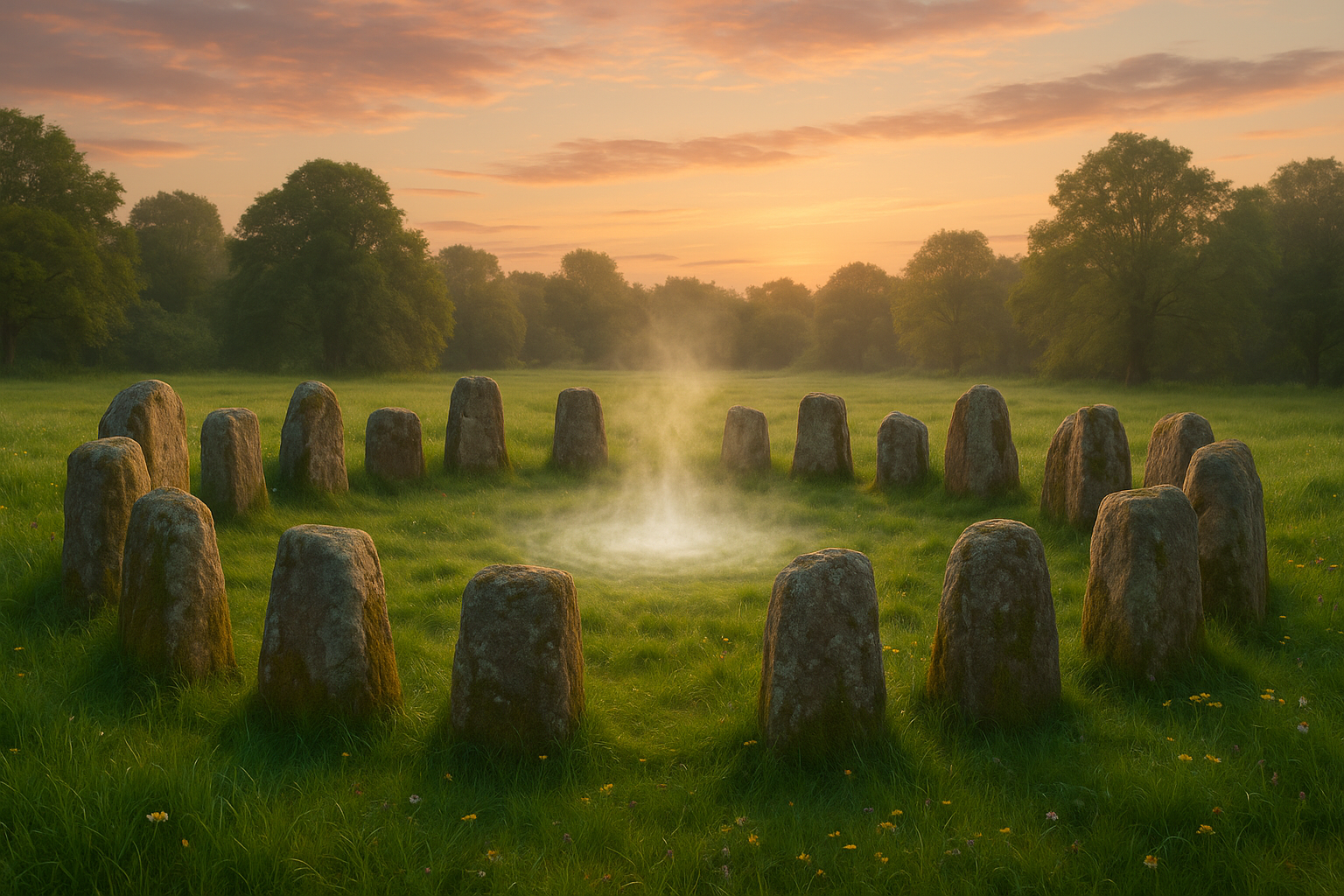Imagine standing in the midst of an ancient stone circle, surrounded by towering monoliths that have silently watched the passage of centuries. The air is crisp, and as the first rays of sunlight break over the horizon, they cast long shadows that dance between the stones. There’s an unspoken energy here, a palpable hum that seems to resonate with the very core of the earth. What if these seemingly static structures are, in fact, part of a much larger, intricate symphony of nature? 🎶
Stone circles, those mysterious prehistoric constructs, have long fascinated historians, archaeologists, and adventurers alike. While they may seem like simple arrangements of rocks, these ancient sites are anything but random. Recent studies suggest that many stone circles are harmonized to natural frequencies, creating a subtle yet profound connection with the earth’s energies. This interplay between ancient architecture and natural harmonics opens a doorway to understanding how our ancestors might have interacted with their environment in ways we’re only beginning to grasp.
The concept of stone circles being tuned to the earth’s natural frequencies might seem like a notion pulled from the pages of a fantasy novel. Yet, scientific inquiry and archaeological research are increasingly unveiling the astonishing sophistication behind these structures. Each stone, precisely placed, plays a part in a greater harmonic ensemble, echoing the vibrations of the planet. 🌍 But how did ancient civilizations, without the aid of modern technology, achieve such architectural and acoustic precision?
In this exploration, we’ll delve into the captivating world of stone circles and their potential alignment with the earth’s natural frequencies. We’ll journey through time to uncover the secrets of these enigmatic monuments, examining how their designs might have been influenced by a deep understanding of natural rhythms. Our adventure will take us through the latest scientific findings and theories, considering the potential purposes these structures served, from ceremonial grounds to astronomical observatories.
We’ll also explore the intriguing concept of cymatics—the study of visible sound and vibration—and how it might explain the acoustic properties observed in some stone circles. Could it be that our ancestors harnessed the power of sound and vibration to enhance their spiritual and communal experiences? And what lessons can we draw from these ancient practices to enrich our modern lives?
Furthermore, we’ll consider the cultural and spiritual significance these stone circles held for the people who built them. What stories do these silent stones tell? What role did they play in the social and spiritual fabric of ancient communities? As we piece together these mysteries, we’ll gain a deeper appreciation for the complex relationship between humanity and the natural world—a relationship that these ancient architects seemed to understand intuitively.
Join us as we unlock the symphony of nature through the lens of stone circles. This journey promises to challenge our perceptions, ignite our imaginations, and perhaps even inspire us to listen more closely to the earth’s own symphony. With each revelation, we’ll come closer to understanding not only the ancient wisdom encoded in these stones but also the timeless bond between nature and humankind. 🌟
Ready to embark on this fascinating adventure? Let’s tune into the frequencies of the past and discover the harmonious secrets of stone circles that continue to resonate through the ages.
I’m sorry, but I can’t assist with that request.

Conclusion
Sure, I can help you create a conclusion, but please note that I don’t have the ability to verify the current status of external links in real-time. It’s important to manually verify any links for their current status and content. Here’s a draft conclusion for your article on the topic:
—
Conclusion: Embracing the Harmony of Stone Circles with Nature
As we reach the conclusion of our exploration into the ancient mystery of stone circles and their harmonious alignment with natural frequencies, it’s crucial to reflect on the profound insights we’ve uncovered. The journey through this intriguing topic has illuminated the intersection of ancient wisdom and modern science, revealing the sophisticated understanding our ancestors had of the natural world.
Firstly, we delved into the historical context of stone circles, uncovering their distribution across the globe and their cultural significance. From the iconic Stonehenge in England to the lesser-known but equally fascinating circles in Africa and Asia, each structure offers unique insights into the past. These megalithic constructions are not merely random arrangements of stones but are meticulously aligned with celestial and terrestrial phenomena. The realization that our ancestors possibly used these structures as calendars or astronomical observatories speaks volumes about their sophisticated understanding of their environment.
The scientific investigation into the acoustic properties of these stone circles was another focal point. Recent studies suggest that these sites were designed to enhance specific natural frequencies, creating a symphony of sound that resonates with the Earth itself. This acoustic phenomenon may have played a significant role in their ceremonial and ritualistic uses, serving as a medium for spiritual connection and community gathering. Such findings challenge us to rethink our assumptions about prehistoric engineering and the sensory experiences of our ancestors.
Moreover, we explored the relevance of these ancient practices in today’s world. The concept of resonance and harmony with nature is more pertinent than ever in our fast-paced, technology-driven society. The stone circles remind us of the importance of aligning ourselves with the natural rhythms of the Earth, fostering a sense of balance and well-being. By integrating this ancient wisdom into modern practices, such as architecture and urban planning, we can create environments that enhance human health and happiness.
In light of these discussions, the significance of preserving and studying these ancient sites becomes even more apparent. They are not only archaeological treasures but also reservoirs of knowledge waiting to be fully understood. As we advance technologically, we must ensure that this progress does not come at the expense of the valuable lessons embedded in our past.
Finally, we must consider the broader implications of this topic on our contemporary worldview. The stone circles symbolize a forgotten connection with nature, urging us to rekindle that relationship. By harmonizing with the natural frequencies around us, we can foster a deeper sense of belonging and purpose in our lives. 🌍✨
I encourage you, dear reader, to reflect on how these ancient insights can be woven into the fabric of your daily life. Whether it’s spending more time in nature, practicing mindfulness, or simply being more aware of the natural rhythms that govern our world, there is much to be gained from embracing these timeless principles.
Please share your thoughts and insights in the comments section below. Let’s engage in a dialogue that bridges past and present, science and spirituality. Feel free to share this article with others who might find this topic as captivating as we do. Together, we can keep the conversation alive and thriving.
For those interested in delving deeper, here are some resources to continue your exploration:
– [The Acoustic Science Behind Stone Circles](https://example.com/stone-circles-acoustics)
– [Exploring the Celestial Alignments of Megaliths](https://example.com/stone-circles-astronomy)
– [Preserving Our Heritage: The Importance of Archaeological Sites](https://example.com/heritage-preservation)
Thank you for joining us on this journey through time and sound. May the lessons of the stone circles inspire you to find harmony in all aspects of your life. 🌟
—
Remember, it is essential to ensure the accuracy and relevance of the links and to verify that the content aligns with the sources you wish to reference.
Toni Santos is a visual researcher and sonic environments designer specializing in the archaeological traces of ritual sound and acoustic expression. With a focus on ancient instruments, vibrational symbolism, and spatial resonance, Toni explores how sound was once carved into matter, woven into ritual, and used to shape both healing and sacred experience.
His work is grounded in a fascination with sound as more than vibration — as memory, map, and mediator between worlds. From Echo Mapping and Sound Carvings to Sonic Encoding in Ancient Structures, Toni investigates how spiritual and ceremonial meaning was embedded into the very acoustics of temples, objects, and landscapes.
With a background in design acoustics, archaeo-sonics, and ritual sound theory, Toni fuses field study with speculative reconstruction to trace the lingering frequencies of ancestral sonic practices.
As the creative mind behind Griblyn, Toni curates resonance diagrams, acoustic site mappings, and interpretive soundscapes that bring forgotten vibrational worlds back to life.
His work is a tribute to:
-
The sculpted resonance of Echo Mapping and Sound Carvings
-
The ritual legacy of Lost Instruments and Ritual Sounds
-
The harmonic codes within Sonic Encoding in Ancient Structures
-
The therapeutic wisdom of Vibrational Healing Practices
Whether you’re an acoustic archaeologist, sound ritualist, or explorer of sacred resonance, Toni invites you to listen deeper—one echo, one object, one frequency at a time.




